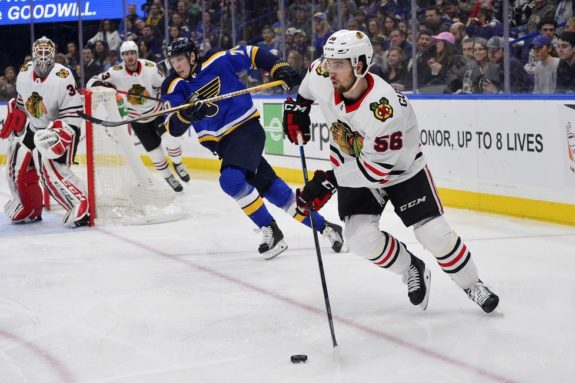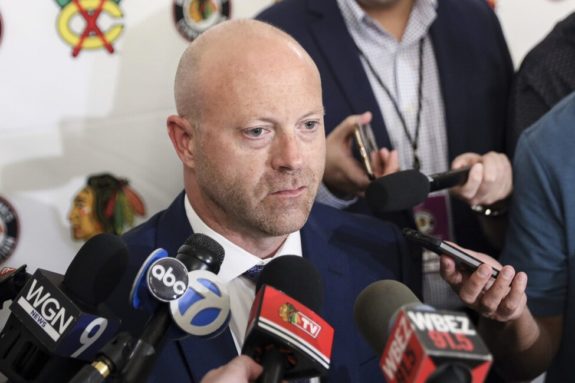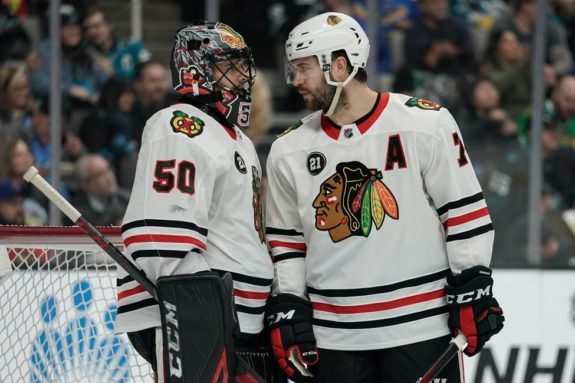To make the playoffs, the Chicago Blackhawks absolutely need defenseman Erik Gustafsson and the offense he provides from the blue line. If only things were that simple, though.
Gustafsson Headed Towards Free Agency
Obviously they’re not. Gustafsson is a pending unrestricted free agent. As a result, the Hawks risk losing him for nothing. That would be a mighty disappointing loss, as he broke out in a big way last season with 60 points in his first full NHL campaign.

Had the question of trading him been asked, say a few weeks ago, before the Blackhawks won five of their last six games (by a combined, dominant 25-13 score no less), there should have been no hesitation on general manager Stan Bowman’s part: Trade him; Get what you can. There may not be another chance.
After all, there are no guarantees Gustafsson will re-sign or if the Blackhawks even have the space to retain him. Bowman has undeniably been one of the best GMs in the league overall for a while. Remember the Blackhawks have won three Stanley Cups during his tenure. However, it’s just as much of a certainty that the Blackhawks are in salary cap hell after years upon years of active mismanagement on his part.
Bowman Makes a Few Missteps
It’s arguably what separates Bowman from the very best and the Blackhawks from elite status at this stage. I mean, they may be benefiting from long-term-injured-reserve (LTIR) cap relief, but, ironically, that’s no long-term solution.

Defenseman Brent Seabrook’s albatross of a $6.875 million hit is expected back on the books next season. Similarly, so are those of fellow-blue-liner Calvin De Haan ($4.55 million) and forward Andrew Shaw ($3.9 million). A case can be made that the output of each of those players is far from worth their respective salaries.
Meanwhile, yes, goalies Corey Crawford and Robin Lehner’s $11 million combined is coming off instead. However, someone’s got to play in net and if the Blackhawks want to compete they’re going to have to pay a good chunk of that to someone, whether it’s to Lehner, who would be due for a raise, or a replacement.
Furthermore, Alex DeBrincat’s $6.4 million cap hit comes into effect. He had been projected to become a restricted free agent at the end of this coming season, but the two sides came to terms on a three-year bridge deal in October. Saying nothing of the wisdom (or lack thereof) of signing a forward of his caliber to such a short term, Bowman still has to re-sign emerging-Calder Trophy-candidate Dominik Kubalik and Dylan Strome, each of whom are also set to become restricted and are arguably more important than Gustafsson.
Granted, Gustafsson is the leading scorer among defensemen on the team with 24 points in 50 games so far. However, he’s clearly off his pace from last year and what’s just as valid of a question as the titular one of this piece is what exactly do the Blackhawks have in him? And will he be worth the inevitable increase in salary he’s getting come July 1?
Nothing Wrong with Gustafsson?
Bowman needs to a) prioritize and b) learn from past mistakes (i.e., Seabrook, for example). The team’s defense remains an issue, in spite of his offseason acquisitions like Olli Maatta. Considering Gustafsson is averaging just 10 seconds of penalty-kill time per game and has been started in the offensive zone most of the time (55.4%), the Blackhawks have clearly identified him as a liability in that regard.

There’s nothing inherently wrong with Gustafsson. Many NHL defenders play as “offensemen” and do it while receiving a steady and hefty paycheck. However, the Blackhawks need actual help in their own zone and, by their own apparent admission through Gustafsson’s deployment, they don’t believe he’s the one to give it to them.
In fact, the Blackhawks currently give up a last-in-the-league 35.2 shots per game. However, what’s encouraging is, over the course of the recent 5-1 run, they’ve given up a respectable average of 31.5 (getting 32.2 on the other net in process). It’s unclear how sustainable the success is, but, mere points out of the second wild-card spot, they’ve clearly got to go for it.
Now, they shouldn’t go all-in, by any stretch, but simply giving up and becoming a seller at this juncture would be foolhardy. It would be about as crazy as dealing away a defenseman who is capable of netting 60 points but carries a cap hit of just $1.2 million.
Of course, there’s a catch. The rub is Gustafsson will carry a much higher hit sooner rather than later. At that point, cut bait if for no other reason than out of fiscal necessity. For now though, Gustafsson gives the Blackhawks something no one else on their roster does. In effect, he’s the rental player another team in their exact position would think about acquiring at the trade deadline. Why not them instead? Hell, why not them period?